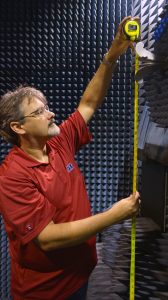
Vince Rodriguez checks the elevation of a broadband, dual polarized antenna in the spherical near-field antenna measurement anechoic range at NSI-MI in Suwanee, Georgia. Submitted photo
Vince Rodriguez literally has written his way to success.
The three-time University of Mississippi electrical engineering graduate (BSEE 94, MS 96, PhD 99) has written 30 journal and magazine articles and over 58 conference papers. Most recently, Rodriguez authored “Anechoic Range Design for Electromagnetic Measurements,” a textbook on the subject.
The electromagnetic anechoic chamber was invented in the early 1950s. Just about every major aerospace company has a multitude of them located throughout the United States and the world. Now, because of the stringent electromagnetic interference requirements that must be considered in the development of all new electronic products, these chambers are appearing in the automotive, telecommunications, computer and other industries.
“The thought of writing a book on the subject of anechoic ranges for electromagnetic measurements has been in my mind for about nine years,” said Rodriguez, a staff engineer at NSI-MI Technologies. “When my colleagues kept pushing the idea, I decided that maybe I should write this book.”
Before Rodriguez’s book, the only other book on the subject was over 18 years old and did not go into details.
“Writing the book was a great learning experience in which I had to correct my own conclusions presented in previous papers,” he said. “You never finish learning.”
Born in Madrid, Spain, Rodriguez was raised there until his 17th birthday. His parents, who married in New York City, were forced into exile in Spain after the Cuban Revolution. His father offered to pay for his college education if he wanted to study in the U.S.
Rodriguez looked at several colleges in the South before deciding to attend Ole Miss.
“I took the Greyhound from New York City to Oxford via Washington, D.C.; Richmond, Virginia; Nashville and Memphis,” he said. “I remember stepping off the bus at the Greyhound stop on Van Buren, about two blocks from the Square. I used the phone to call the contact person at the international students office. I still have my receipt from the bus fare.”
Rodriguez said though he found the university community to be welcoming and supportive, he initially struggled with both academics and communication skills.
“My math skills were really poor,” he said. “All my teachers took the time to explain things to me. My classmates and I studied together, too.”
Rodriguez named the late Charles E. Smith Sr., Atef Elsherbeni and Richard Gordon as some of his favorite engineering professors.
“Dr. Smith and Dr. Elsherbeni were my mentors,” he said. “Dr. Elsherbeni pushed me, made me work hard and put his trust in me. Because of him, I had three journal publications and several conference papers published by the time I graduated with my doctorate.”
Following completion of his doctorate, Rodriguez began his career in academia as a visiting assistant professor at Texas A&M-Kingsville. After one year, he realized he wanted to pursue a different path.
“By June 2000, I had started at EMC Test Systems (now ETS-Lindgren), a company in Austin, Texas, where I spent 14 years,” he said. “At ETS-Lindgren, I built my career and started becoming well known in the electromagnetic measurement segment.”
Rodriguez’s achievements included antenna designs, absorber designs and tests of chamber layouts.
He credited his success to the Ole Miss electrical engineering department’s insistence on oral presentations and the strong science base of the engineering program.
“That engineering science approach taught me to understand the physics behind technology,” he said. “Regardless of the technology, the physics do not change.”
Rodriguez also credited Smith’s advice to keep his designs simple. Following Smith’s wisdom has paid off several times over in his career.
“Chances are, if you own an iPhone, it was tested at some point with one of the antennas that I designed for ETS-Lindgren,” he said. “If you drive a GM vehicle, that model was tested using antennas that I designed.”
Rodriguez not only designed antennas; he also designed the anechoic absorber layout (an ultra broadband absorber that has been optimized for electromagnetic applications) used in the chambers where these tests are conducted. He has designed anechoic layouts for facilities in five continents and in more than 15 different countries, including a large anechoic range located in Forest, Mississippi.
In 2014, Rodriguez joined MI Technologies (now NSI-MI) in Suwanee, Georgia. NSI-MI is a global supplier of antenna, RF and microwave testing equipment. His duties include designing anechoic layouts for antenna measurement chambers, radar cross-section measurement ranges and target simulators or EM scene generators for testing targeting systems.
“I also do the high-level design for some measurement systems, choosing the instrumentation required, the components needed to achieve the customer’s goals,” he said. “I help keep costs low in implementing the solution.”
UM School of Engineering officials said Rodriguez is a shining example of the caliber of its alumni.
“He personifies successful EE Ole Miss alumni by showing how hard work and brilliance pay rich dividends,” said Ramanarayanan Viswanathan, chair and professor of electrical engineering. “Vince has been contributing back to the department by giving invited talks to students, serving on doctoral committees and providing technical help through his company for our antenna test and measurement setup. We are proud to claim that he is our own.”
Dean Dave Puleo agreed.
“Dr. Rodriguez exemplifies many of the traits we instill in graduates of Ole Miss Engineering,” he said. “His book demonstrates many of these, including critical analysis, communication skills and the desire for lifelong learning. We look forward to watching both his engineering and writing careers progress.”
With his first book behind him, Rodriguez predicts the volume will become a reference used by future authors on the subject.
“Time will tell,” he said. “No doubt the RF absorber will be different in 50 years. But the basics found in my book, the reasons why things are done and how the EM energy interacts with the media, that will not change.”